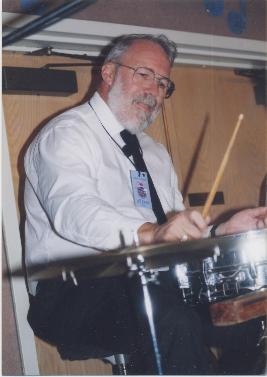CD REVIEW
by Bert Thompson
Benny Goodman and His Orchestra and Sextet—THE COMPLETE AFRS BENNY
GOODMAN SHOWS VOL. 7 (Sounds of Yesteryear DSOY852). Playing time: 60m.
50s.
Show Fifteen: 10th October, 1946. Guest: Edward G. Robinson
Introduction; After You’ve Gone; Comedy: Victor Borge and Don Wilson; Pity the
Poor Lobster; St. Louis Blues; Comedy: Victor Borge and Edward G. Robinson;
Prelude in C Sharp Minor (S. Rachmaninoff); The Sheik of Araby; Comedy: Victor
Borge and Edward G. Robinson; Closer: Goodbye
Show Sixteen: 16th October, 1946. Guest: Charlie “Finegan” Cantor
Introduction; King Porter Stomp; Comedy: Victor Borge and Don Wilson; If You
Were the Only Girl in the World; Hora Staccato; Comedy: Victor Borge and Charlie
Cantor; Warsaw Concerto; Honeysuckle Rose; Comedy: Victor Borge and Charlie
Cantor; I Know That You Know; Closer: Goodbye.
Personnel - Orchestra: Benny Goodman - clarinet; John Best, Nate Kazebier, Dick
Mains, Dale Pierce – trumpets; Leon Cox, Cutty Cutshall – trombones; Addison
Collins - french horn; Larry Molinelli, Bill Shine - alto saxes; Cliff Strickland, Zoot
Sims - tenor saxes; John Rotella - bass sax; Joe Bushkin – piano; Barney Kessel –
guitar; Harry Babasin – bass; Louis Bellson – drums; Johnny White – vibes; Art
Lund – vocal.
Personnel - Sextet: Benny Goodman - clarinet; Joe Bushkin – piano; Barney Kessel –
guitar; Harry Babasin – bass; Louis Bellson – drums; Johnny White – vibes.
This CD is titled Benny Goodman and His Orchestra and Sextet, Volume Seven of
the Complete AFRS Benny Goodman Shows. On the cover Benny Goodman and
His Orchestra and Sextet is given emphasis by the large size of the font in the first
part of the title and the repetition of his name in the second. Further emphasis is
given by the picture of Goodman that takes up almost half of the front cover.
However, all of that is misleading. A little less than half of the content is by the
Goodman musical groups—some 28 minutes, the other 33 minutes being given to
Borge’s comedy and piano features. I suppose, given the Goodman emphasis, that
the intended audience is the Goodman one, but it is being given short shrift. Tracks
1, 2, 4, 10-15, 20, and 21 feature the Goodman band, while 5, 8, and 18 showcase the
sextet. Of the band tracks, 1, 10, 11, and 21 are actually snippets since they are
background for the MC, and 4 and 14 are backing for Lund’s vocals.
One would expect that with names such as Cutty Cutshall, Zoot Sims, Joe Bushkin,
Barney Kessel, and Louis Bellson backing the leader the music would be of high
quality, as indeed it is. The first show, that of 10th October, 1946, begins with a
cracking romp through After You’ve Gone. Following that is Pity the Poor Lobster, a
simple but catchy tune with eminently forgettable lyrics that probably had Lund
blushing while singing them. It is succeeded by the sextet’s version of St. Louis
Blues, an interesting arrangement with a pair of double-time choruses following the
solos by Bushkin and White, leading to the coda.
On The Sheik of Araby, the next musical selection, solos are passed around in the
sextet’s tight arrangement with its breaks, only Bellson and Babsin not being given
one. It’s interesting that with Babasin’s presence, Bellson does not have to “pound
the bass drum” à la Krupa but can just lay down the odd accent with it. The
broadcast closes with a truncated version of Goodman’s sign-off, Goodbye.
On the second broadcast, 16th October, 1946, a familiar Goodman piece is the
opening number, King Porter Stomp, that cooks right through to the trading of two
bar riffs between the brass section and the reeds going into the coda. Lund then
sings on the slow waltz If You Were the Only Girl in the World. Following that,
Goodman solos on an arrangement of Hora Staccato, playing it “straight” almost all
the way through until he swings a couple of choruses toward the end. The sextet’s
number in this broadcast is Honeysuckle Rose. Vintage small group it is, following
arrangements of previous performances of this tune, and I almost expected
Hampton’s trademark grunts during White’s solo. The last number is I Know That
You Know, which Bellson and rest of the rhythm section keep driving to a
satisfying climax. The disc ends with the short version of Goodbye.
I haven’t heard any of the volumes that precede this, the seventh, so I’m not sure if
the “Goodman: other” ratio holds with them, too. While old time radio buffs and
perhaps cultural historians will probably appreciate having the entire broadcasts,
for those interested only in Goodman’s music the long spaces between the musical
tracks seem even longer, given the quality of the humor. Judging by their response,
the audience back then found it riotously funny; I found it very “corny.” And
Edward G. Robinson as a comedian? Please. Goodman aficionados would have
been better served by omitting all the “comedy” and leaving just the musical
portions—perhaps from four shows per CD. As it is, the disc will appeal mainly to
Goodman completists, and they will have to be ready to do quite a bit of fast
forwarding.
|
|


